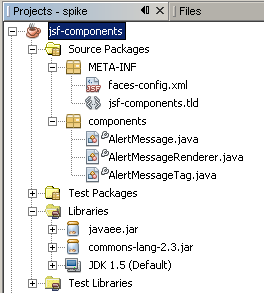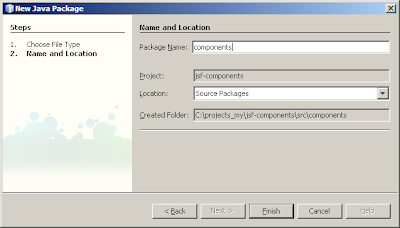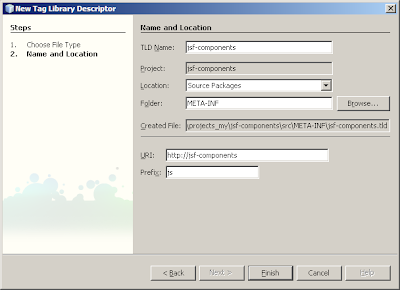The other day I was tasked with creating feedback messages for a JSF-based application as JavaScript alert dialogues. JSF already got a tag for displaying messages attached to components (<h:message /> and <h:messages />), however they are limited to render the text using a given cascading style sheet class for each level of severity.
This entry will show how to build a custom JSF message tag for rendering the messages as a JavaScript alert.
There are many excellent tutorials and blog entries out there describing JSF component development much better than I am capable of. So, I'll just focus on what is needed to create this specific component. My instructions are based on NetBeans 6.0, but they don't including anything that is not possible to do in other IDEs, so you should be able to translate the instructions into your own IDE.
We will keep the tag simple with one attribute, for, which will specify for which component the messages should be displayed. The signature of the tag will therefore be: <jc:alertMessage for="myForm" />.
1. Fire up NetBeans
2. Create a new Java Class Library Project (I've called mine jsf-components)
Before we continue let me briefly explain what we need:
META-INF/jsf-components.tld- Tag library descriptor declaring your tag and defining its attributes
META-INF/faces-config.xml- Declares the tag in the faces application
components/AlertMessage.java- Class representing the user interface component with properties for each attribute supported by the tag. It's recommended to sub-class one of the existing components to avoid doing all the work yourself.
components/AlertMessageRenderer.java- Class for rendering the content of the tag. This is the class where we will actual construct the HTML/Javascript code that is outputted to the browser.
components/AlertMessageTag.java- Class representing the actual tag.

Now that we know what to do - lets get on with it.
3. Create the
components package in the Source Packages
3a) Right click Source Packages
3b) Select 'New'
3c) Select 'Other'
3d) Select 'Java'
3e) Select 'Java Package'
3f) Click 'Next'
3g) Enter
components as the package name3h) Click 'Finish'
4. Create the tag library descriptor
4a) Right click Source Packages
4b) Select 'New'
4c) Select 'Other'
4d) Select 'Web'
4e) Select 'Tag Library Descriptor'
4f) Click 'Next'
4g) Enter the following information:

- TLD name:
jsf-components - URI:
http://jsf-components - Prefix:
jc
4h) Click 'Finish'
5. Add the javaee.jar from the GlassFish project (
%GLASSFISH%/lib) to the library dependencies of the project.6. Create the Java class for the UI component, AlertMessage subclassing the
UIMessage component.
package components;
import javax.faces.component.UIMessage;
public class AlertMessage extends UIMessage {
private static final String MSG_COMPONENT_TYPE = "components.alertmessage";
private static final String MSG_COMPONENT_FAMILY = "javax.faces.Message";
@Override
public String getFamily() {
return MSG_COMPONENT_FAMILY;
}
@Override
public String getRendererType() {
return MSG_COMPONENT_TYPE;
}
@Override
public String getFor() {
return super.getFor();
}
@Override
public void setFor(String forParam) {
super.setFor(forParam);
}
}
7. Create the Java class for the tag, AlertMessageTag subclassing the
UIComponentELTag tag.
package components;
import javax.el.ValueExpression;
import javax.faces.component.UIComponent;
import javax.faces.webapp.UIComponentELTag;
import javax.servlet.jsp.JspException;
import javax.servlet.jsp.PageContext;
import javax.servlet.jsp.tagext.Tag;
public class AlertMessageTag extends UIComponentELTag {
private ValueExpression forParam;
private static final String MSG_COMPONENT_TYPE = "components.alertmessage";
private static final String MSG_RENDERER_TYPE = "components.alertmessage";
@Override
public String getComponentType() {
return MSG_COMPONENT_TYPE;
}
@Override
public String getRendererType() {
return MSG_RENDERER_TYPE;
}
@Override
protected void setProperties(UIComponent component) {
super.setProperties(component);
AlertMessage em = (AlertMessage) component;
em.setValueExpression("for", forParam);
}
@Override
public int doEndTag() throws JspException {
return super.doEndTag();
}
@Override
public int doStartTag() throws JspException {
return super.doStartTag();
}
@Override
public void setPageContext(PageContext ctx) {
super.setPageContext(ctx);
}
@Override
public void setParent(Tag tag) {
super.setParent(tag);
}
public void setFor(ValueExpression forParam) {
this.forParam = forParam;
}
}
9. Create the Java class for rendering the tag, AlertMessageRenderer subclassing the JSF
Renderer.
package components;
import java.io.IOException;
import java.util.Iterator;
import javax.faces.application.FacesMessage;
import javax.faces.component.UIComponent;
import javax.faces.context.FacesContext;
import javax.faces.context.ResponseWriter;
import javax.faces.render.Renderer;
import org.apache.commons.lang.StringEscapeUtils;
public class AlertMessageRenderer extends Renderer {
@Override
public void encodeBegin(FacesContext context, UIComponent component) throws IOException {
AlertMessage alertMessage = (AlertMessage) component;
// Locate the component for which to display messages
UIComponent forComponent = alertMessage.findComponent(alertMessage.getFor());
// If the component could not be found end processing
if (forComponent == null) {
return;
}
// Iterate through messages for the component
Iterator iter = context.getMessages(forComponent.getClientId(context));
if (iter.hasNext()) {
ResponseWriter writer = context.getResponseWriter();
// Start the script tag
writer.startElement("script", alertMessage);
writer.writeAttribute("type", "text/javascript", null);
// Construct one big string of all messages
StringBuffer message = new StringBuffer();
while (iter.hasNext()) {
FacesMessage msg = (FacesMessage) iter.next();
if (message.length() > 0) {
// Separate each message with the JavaScript escape code
// for newline
message.append("\n");
}
message.append(msg.getSummary());
}
// Escape the constructed string to be outputable as a JavaScript
String displayMessage = StringEscapeUtils.escapeJavaScript(message.toString());
// Output the javascript code for displaying the alert dialogue
String jsAlert = "alert('" + displayMessage + "');";
writer.writeText(jsAlert.toCharArray(), 0, jsAlert.length());
// End the script tag
writer.endElement("script");
}
}
@Override
public void decode(FacesContext ctx, UIComponent component) {
if (ctx == null || component == null) {
throw new NullPointerException();
}
}
}
Notice that I'm using
StringEscapeUtils.escapeJavaScript(String) from the Apache Commons Lang library to ensure the correct output of the JavaScript code.10. Update the tag library descriptor to reflect the created component:
<?xml version="1.0" encoding="UTF-8"?>
<taglib version="2.0" xmlns="http://java.sun.com/xml/ns/j2ee" xmlns:xsi="http://www.w3.org/2001/XMLSchema-instance" xsi:schemaLocation="http://java.sun.com/xml/ns/j2ee web-jsptaglibrary_2_0.xsd">
<tlib-version>1.0</tlib-version>
<short-name>jc</short-name>
<uri>http://jsf-components</uri>
<tag>
<name>AlertMessage</name>
<tag-class>components.AlertMessageTag</tag-class>
<body-content>JSP</body-content>
<attribute>
<description>
The ID of the component whose attached FacesMessage object
(if present) should be diplayed by this component.
</description>
<name>for</name>
<required>true</required>
<deferred-value/>
</attribute>
</tag>
</taglib>
11. Create the faces configuration (
META-INF/faces-config.xml) for the component:
<?xml version='1.0' encoding='UTF-8'?>
<faces-config version="1.2" xmlns="http://java.sun.com/xml/ns/javaee" xmlns:xsi="http://www.w3.org/2001/XMLSchema-instance" xsi:schemaLocation="http://java.sun.com/xml/ns/javaee http://java.sun.com/xml/ns/javaee/web-facesconfig_1_2.xsd">
<component>
<component-type>components.alertmessage</component-type>
<component-class>components.AlertMessage</component-class>
</component>
<render-kit>
<renderer>
<description>Renderer for the alert message component.</description>
<component-family>javax.faces.Message</component-family>
<renderer-type>components.alertmessage</renderer-type>
<renderer-class>components.AlertMessageRenderer</renderer-class>
</renderer>
</render-kit>
</faces-config>
12. Build the class library
All you need to do now is to place the jsf-components.jar into your web application, declare the tag library (
<%@taglib prefix="jc" uri="http://jsf-components" %>) on the pages where you want to use the tag (<jc:alertMessage for="componentId" />). Example:
<%@page contentType="text/html"%>
<%@page pageEncoding="UTF-8"%>
<%@taglib prefix="f" uri="http://java.sun.com/jsf/core"%>
<%@taglib prefix="h" uri="http://java.sun.com/jsf/html"%>
<%@taglib prefix="jc" uri="http://jsf-components" %>
<!DOCTYPE HTML PUBLIC "-//W3C//DTD HTML 4.01 Transitional//EN" "http://www.w3.org/TR/html4/loose.dtd">
<html>
<head>
<meta http-equiv="Content-Type" content="text/html; charset=UTF-8">
<title>Example of AlertMessage component</title>
</head>
<body>
<f:view>
<h:form>
<jc:AlertMessage for="numberField" />
<h:inputText id="numberField">
<f:validateLength minimum="5" maximum="10" />
<f:validateLongRange minimum="10000" maximum="222222" />
</h:inputText>
<h:commandButton value="Submit" action="reload" />
</h:form>
</f:view>
</body>
</html>

UPDATE (30. July 2008): Facelets Support
You can use the component with Facelets by providing a Facelets Tag Library descriptor. In this example I name the tag library descriptor
mycomponents.taglib.xml and place in the WEB-INF/ directory.The contents of the descriptor is:
<?xml version="1.0"?>
<!DOCTYPE facelet-taglib PUBLIC "-//Sun Microsystems, Inc.//DTD Facelet Taglib 1.0//EN" "http://java.sun.com/dtd/facelet-taglib_1_0.dtd">
<facelet-taglib>
<namespace>http://jsf-components</namespace>
<tag>
<tag-name>alertMessage</tag-name>
<component>
<component-type>components.alertmessage</component-type>
<renderer-type>components.alertmessage</renderer-type>
</component<
</tag<
</facelet-taglib<
Next you need to reference the descriptor in
web.xml using the facelets.LIBRARIES context parameter:
<context-param>
<param-name>facelets.LIBRARIES</param-name>
<param-value>/WEB-INF/mycomponents.taglib.xml</param-value>
</context-param>
Remember that if you have more than one Facelets Tag Library Descriptor, to separate them using semicolons (;)

23 comments:
Nice writeup, will sure come in handy. Thanks for the explanation.
Good work man!!
suggest a excellent JSF create component tutorial, please.
And post the link of the apache library.
I like you post. It very good.
But, when I implementations there is a error:
org.apache.jasper.JasperException: Unable to convert string "idlogin" to class "javax.el.ValueExpression" for attribute "for": Property Editor not registered with the PropertyEditorManager
Do you know why???
I don't know to do.
Thanks
Hi Mirla,
Thanks for visiting my blog.
Which version of JSF are you using?
Kind regards,
Allan
Hello Allan
I am using the version JSF 1.2
that come wiht JBoss 4.2.2
Thanks
Hi,
This is a nice tutorial on creating custom JSF component.
I would just like to ask how will I implement the messages version of this...
Thanks, and more power!!!
Hi,
Thanks for writing this up. I was getting some errors about not being able to find a NamedObject from this line:
private static final String MSG_COMPONENT_TYPE = "components.extendedmessage";
So I changed it to "components.alertmessage" because I figured there was not a ExtendedMessage object anywhere.
Do you know what happened. It works find with the above changes
Thanks for pointing out the problem with the component type. It was a mistake on my side when I transferred my code to the blog. I will fix the code in the entry right away.
Hi,
How would I use the same with Facelets ? What enteries are needed in taglib.xml . I am not sure which will come as component or handler class ?
Please let me know.
To use any custom component with Facelets you need to provide a tag library descriptor specifically for Facelets. The tag library descriptor contains the namespace and component and render type for each of your components in the library. Once the descriptor is complete you must reference it using the facelets.LIBRARIES context parameter in web.xml.
I've added the instructions to the end of the blog.
Enjoy.
This is very nice post about creating custom component, it is for H:message so I followed this same meterial and build a custome h:messages by modifying some parts of the code. So if anybody is looking for h:messages custom component then visit this link
http://www.jaininaveen.com/?page_id=23
Thanks. Nice. But I followed your instructions, got error:
org.apache.jasper.JasperException: Unable to convert string "xyz" to class "javax.el.ValueExpression" for attribute "for": Property Editor not registered with the PropertyEditorManager
I am using jsf ri 1.2 and jboss 5.0.1 GA. Thanks for help.
Dave
Hi Dave,
It's a bit hard to see what might have gone wrong. Did you change any of the code, or did you copy it verbatim?
Hello is,
jsf-components is the product of the blog entry. I haven't provided a pre-compiled output of the code. If you create the code as described in the blog, you'll end up with jsf-components.jar.
Hope that helps.
Regards,
Allan
THINK YOU VERY MUCH Allan Lykke Christensen
I Create all the classes the tld file ...
but i used eclipse IDE
where can i find the jar ...
please really help in my project think you very much i delete my post cause ...i have asked for facelet
but i still used the
classic tag definition
thinks for you again
Hi is,
No need to delete your posts - someone else might have the same issues as yourself.
I've decided to create a project for my JSF utility library on Kenai. I'll post the URL once I've finished uploaded the library (20 -30 mins).
Regards,
Allan
OK ok ...that's fine
i undrestand ..
...you mean to create this project alone ...
i'm really sorry ..i think that was to implement this classe into my jsf project ...
OK i think i will do it now arllight
sorry i'm just a beginner
i have only one month in JEE world :p
have a good night and think for the help
Merci beaucoup Monsieur
Oh really ...I'm waiting for so :)
that will really great
to post it
After your permission
i have create it
and i post it there
http://www.4shared.com/file/103214665/2f019e99/jsf-components.html
but i'm still testing if everything gonna fine
and waiting for your post
Hi is,
I created a project for my JSF utilities at Kenai: http://kenai.com/projects/i2m-jsf
You can download the first version of the utilities from here:
http://kenai.com/projects/i2m-jsf/downloads/directory/Version_1.0Simply add i2m-jsf-1.0.jar to your WEB-INF/lib directory and you are ready to go.
Hi
Allan
i would like to think you very much
Post a Comment